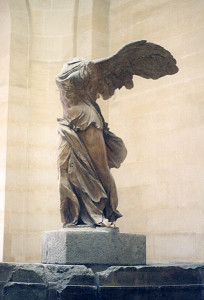One of the most valued works of art of the Louvre Museum is a gigantic headless statue – almost two and half meters long – of a female figure, with huge wide-spread wings. The figure’s drapery seems animated, suggesting that she is in motion, and the body itself reveals a strenuous movement. The intensity of the figure is overwhelming: she is strong, vibrant, dynamic.
Nike of Samothrace, also called ‘Winged Victory of Samothrace’, is a marble sculpture of Nike, the Greek goddess of victory. It was discovered in 1863 in Samothrace, an island in the North Aegean Sea, by Charles Champoiseau, a French diplomat and an amateur archeologist. It was headless and armless; one arm was found later, in 1948. The statue is believed to have been created in the early second century BC. Modern excavations suggest that it occupied a niche above a theater, standing on a grey marble structure representing the prow of a ship. The goddess has just descended onto the prow; her wings are still pulled back by the wind. The entire composition most likely commemorated the battle between Rhodes and Antiochus III in the second century BC.
The sculpture has been on prominent display in the Louvre since 1884. In spite of its immense size it was removed for protection from the museum before the outbreak of World War II. In September 1939 a special wooden ramp was constructed in the Louvre in order to carry this gigantic piece of art to a safer place. During the war it was kept in the Chateau de Valencay, together with Michelangelo’s Slaves and other masterpieces.
Surprisingly, the Nike sculpture is extremely expressive in spite of it being headless. Though created with a face and body, arms and wings, the body – in itself – is astounding. We tend to think of outstanding images in traditional art as having both face and body. Portraits can also be uniquely moving – but one can hardly find such a passionate image of a headless body. One wonders, what is it about Nike of Samothrace that makes people gather around her, mesmerized, reluctant to walk away?
The secret of her charm may be not what we see as we look at her, as captivating as she is, but mostly what we do not see: the strong sea breeze Nike is struggling with.
H. W. Janson, a noted art historian, observes a fundamental difference between Nike of Samothrace and all other Hellenistic sculptures: her surroundings are a part of the sculpture itself. The invisible gust that she is facing is a segment of the statue just as much as is the goddess’s body, or her huge wings.
Greek and Roman statues are self-contained. Men or women, well balanced and harmonious, every sculpture is a complete entity, regardless of its positioning. Even if several sculptures together form a mythological scene, each can also be viewed as “detached from the background.”
But Nike of Samothrace is different, argues Janson: “The goddess has just descended upon the prow of the ship; her great wings spread wide, she is still partly air-borne by the powerful head wind against which she advances. This invisible force of on-rushing air here becomes a tangible reality; it not only balances the forward movement of the figure but also shapes every fold of the wonderfully animated drapery. As a result, there is an active relationship—indeed, and interdependence—between the statue and the space that envelops it, such as we have never seen before. Nor shall we see it again for a long time to come. The Nike of Samothrace deserves her fame as the greatest masterpiece of the Hellenistic age.”
Looking at the Nike of Samothrace, I feel profound awe: the genius of the artist, who instilled such intense movement in this huge rock, seems to me unmatched, even in later periods. The motion – abrupt yet frozen – is stunning: Nike is utterly confident, in spite of her manifested effort to overcome the facing wind; she will descend onto the prow of the ship and declare victory, no matter how strong the drafts are. And I can’t help contemplating what her face looked like: was she serene? Smiling lightly? Did her face betray the struggle with the wind, or was she indifferent to anything besides triumph itself?

I went to louvre to see Mona Lisa but what stunned me and didn’t want to leave is Her , a goddess of The sea – The Nike of Samothrace.
Thanks, you put it so beautifully!
La poitrine, comme la proue d’un navire, me donne à penser qu’elle traverse l’espace et le temps, unité sans visage animée par le souffle de création qui donne une sensation de force, d’harmonie et de paix.
It is an extremely rich novel, it could be interpreted from so many persepectives. One of my favorites!
This is a very interesting historical perspective! But Nike – victory – was eventually returned to the Louvre, and thousands look at her ever day.
Looking at the famous sculpture of Nike – there is in the back of my mind quite different picture of it . When packed , ready to be moved in 1939 – doesnt look in that way you discribed Nike . No pride or proud .. not even shadow of splendour ..tangled with rope , surroned with careless nailed planks and with wings which this time they just sticking out miserably …
That what happens to us pple and that what we creat when god of war decides to appear on the stage .
http://twistedsifter.com/2013/05/louvre-and-mona-lisa-world-war-2/